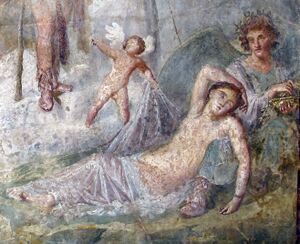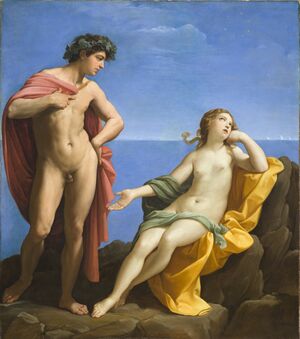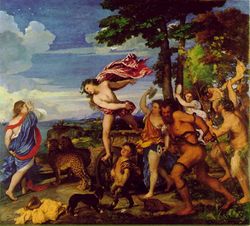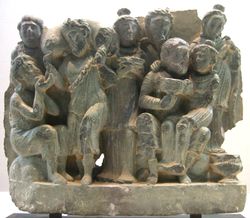أريادنى
| Ariadne | |
|---|---|
Cretan princess; sometimes seen as a goddess associated with mazes | |
 | |
| المسكن | Mount Olympus |
| الرمز | String / Thread, Serpent, Bull |
| معلومات شخصية | |
| الأبوان | Minos and Pasiphaë |
| الأشقاء | Phaedra, Catreus, Deucalion, Glaucus, Androgeus, the Minotaur |
| Consort | Dionysus, Theseus |
| الأنجال | Staphylus and Oenopion |
| المكافئ الروماني | "Arianna" and "Ariadna" in Latin; Hyginus identified Ariadne as the Roman Libera/Proserpina |
أريادنه (باليونانية: Αριάδνη ، إنگليزية: Ariadne) في الأساطير الإغريقية، كانت ابنة مينوس، ملك كريت. وقد وقعت في غرام البطل اليوناني ثسيوس، عندما ذهب إلى كريت، ليقتل الوحش الخرافي المدعو المينوطور. كان المينوطور يعيش في شبكة مُربكة من الممرات تسمّى بالمتاهة. أعطت أريادْني ثسيوس كرة من الخيط عند دخوله المتاهة وذلك حتى يترك أثرًا ويعثر على طريق الخروج. قتل ثيسيوس المينوطور وهرب إلى كريت. وأخذ أرييادني معه ولكنه هجرها في جزيرة ناكسوس. وقد وجد الإله دايونيسوس ـ حسب أساطير اليونان ـ أريادني هناك وتزوجها.
The ancient Roman author Hyginus identified Ariadne as the Roman Libera/Proserpina at approximately the same time as Libera was officially identified with Proserpina in 205 BC, these two names becoming synonymous for the same goddess. Hyginus equated Libera/Proserpina with Ariadne as bride to Liber whose Greek equivalent was Dionysus, the husband of Ariadne.[1]

. . . . . . . . . . . . . . . . . . . . . . . . . . . . . . . . . . . . . . . . . . . . . . . . . . . . . . . . . . . . . . . . . . . . . . . . . . . . . . . . . . . . . . . . . . . . . . . . . . . . . . . . . . . . . . . . . . . . . . . . . . . . . . . . . . . . . . . . . . . . . . . . . . . . . . . . . . . . . . . . . . . . . . . .
Etymology
Greek lexicographers in the Hellenistic period claimed that Ariadne is derived from the ancient Cretan dialectical elements ari (ἀρι-) "most" (which is an intensive prefix) and adnós (ἀδνός) "holy".[2] Conversely, Stylianos Alexiou has argued that despite the belief being that Ariadne's name is of Indo-European origin, it's actually pre-Greek.[3]
Linguist Robert S. P. Beekes has also supported Ariadne having a pre-Greek origin; specifically being Minoan from Crete. This being due to her name containing the sequence dn (δν), which is rare in Indo-European languages, indicating that it is a Minoan loanword.[4]
Family
Ariadne was the daughter of Minos, the King of Crete[5] and son of Zeus, and of Pasiphaë, Minos' queen and daughter of Helios.[6] Others denominated her mother "Crete", daughter of Asterius, the husband and King of Europa. Ariadne was the sister of Acacallis, Androgeus, Deucalion, Phaedra, Glaucus, Xenodice, and Catreus.[7] Through her mother, Pasiphaë, she was also the half-sister of the Minotaur.
Ariadne married Dionysus and became the mother of Oenopion, the personification of wine, Staphylus, who was associated with grapes, Thoas, Peparethus, Phanus, Eurymedon, Phliasus, Ceramus, Maron, Euanthes, Latramys, Tauropolis,[8] Enyeus[9] and Eunous.[10]
| Relation | Names | Sources | |||||||||||||
|---|---|---|---|---|---|---|---|---|---|---|---|---|---|---|---|
| Homer | Hesiod | Apollon. | Diod. | Ovid | Apollod. | Plutarch | Hyginus | Pausa | Quin. | Theophilus | |||||
| Ody. | Sch. Ili. | Ehoiai | Arg. | Sch. | Her. | Met. | Theseus | Fabulae | Autolycus | ||||||
| Parentage | Minos | ✓ | ✓ | ✓ | ✓ | ✓ | |||||||||
| Minos & Pasiphae | ✓ | ✓ | ✓ | ||||||||||||
| Consort | Dionysus | ✓ | ✓ | ✓ | ✓ | ✓ | ✓ | ✓ or | ✓ | ✓ | |||||
| Theseus | ✓ | ||||||||||||||
| Children | Enyeus | ✓ | |||||||||||||
| Thoas | ✓ | ✓ | ✓ | ✓ | ✓ | ✓ | ✓ | ||||||||
| Oenopion | ✓ | ✓ | ✓ | ✓ | |||||||||||
| Staphylus | ✓ | ✓ | ✓ | ✓ | |||||||||||
| Latromis | ✓ | ||||||||||||||
| Euanthes | ✓ | ||||||||||||||
| Tauropolis | ✓ | ||||||||||||||
| Peparethus | ✓ | ||||||||||||||
| Phanus | ✓ | ||||||||||||||
| Phliasus | ✓ | ||||||||||||||
| Eurymedon | ✓ | ||||||||||||||
| Ceramus | ✓ | ||||||||||||||
| Maron | ✓ | ||||||||||||||
| Eunous | ✓ | ||||||||||||||
الأسطورة
وفقا لهوميروس فقد قُتلت أريادني على يد آرتميس بطلب من ديونيسوس في جزيرة ديا قرب كنوسوس قبل أن تصل إلى أثينا مع ثيسيوس، وفي حكاية أخرى تركها بينما كانت نائمة على جزيرة ناكسوس حيث وقع ثيسيوس ضحية لسحر أيغلي، كما يروي بلوتارخ وديودورس واكتشفها ديونيسوس في طريق عودته من الهند وسحر بجمالها وتزوجها وعندما استيقظت، حصلت على تاج كهدية لزواجها ويقع مكانه بين النجوم، أما هي فكرمت كإلهة كما يقول أوفيد.
الاحتفال بها
هناك دلائل على عبادة أريادني حيث كانت تمثل الربيع وفي ناكسوس كان يقام لها احتفال ذو طابع مزدوج حيث يكون من جهة مليئا بالحزن لموتها أو تركها من قبل ثيسيوس ومن جهة أخرى بالفرح لنهوضها وزواجها مثل الطبيعة التي تموت وتنام في الشتاء لكنها تحيا وتستيقظ في الربيع. ويقال أن ثيسيوس أقام احتفالا على شرفها وشرف ديونيسوس عندما رجع إلى أثينا.
أريادني وديونيسوس
قصة ديونيسوس وأريادني كانت من المفضلات في النقوش والرسوم الجدارية وتصور في الغالب نائمة في ناكسوس ويأتيها ديونيسوس ومعه ساتير وكاهن باخوسي وأحيانا يجلسون على نبتة كرمة. وفي المتحف البريطاني يوجد إناء قديم عليه أريادني تحمل الخيط الذي أعطته لثيسيوس، وهناك تمثال لأريادني النائمة في متحف الفاتيكان.
ناكسوس

في هسيود ومعظم الروايات الأخرى، ثسيوس ترك أريادنه نائمة في ناكسوس، وأعاد العثور عليها ديونيسوس وتزوجها. In a few versions of the myth,[11] Dionysus appeared to Theseus as they sailed from Crete, saying that he had chosen Ariadne as his wife and demanding that Theseus leave her on Naxos for him; this had the effect of absolving the Athenian cultural hero of desertion. The vase painters of Athens often depicted Athena leading Theseus from the sleeping Ariadne to his ship.
She bore Dionysus famous children including Oenopion, Staphylus, and Thoas. Her wedding diadem was set in the heavens as the constellation Corona Borealis. Ariadne was faithful to Dionysus. Perseus killed her at Argos by turning her to stone with the head of Medusa during Perseus' war with Dionysus.[12] In the Odyssey,[13] it is told that Artemis killed her. In other myths she hanged herself from a tree, like Erigone and the hanging Artemis, a Mesopotamian theme.[بحاجة لمصدر]. Dionysus then went to Hades, and brought her and his mother Semele to Mount Olympus, where they were deified.[14] Some scholars have posited, because of her associations with thread spinning and winding, that she was a weaving goddess, like Arachne, and support this theory with the mytheme of the Hanged Nymph (see weaving in mythology).[بحاجة لمصدر]
أريادنى كشخصية إلهة محتملة
في الثقافة الإتروسكية
Ariadne, in Etruscan Areatha, is paired with Dionysus, in Etruscan "Fufluns", on Etruscan engraved bronze mirror backs, where the Athenian cultural hero Theseus is absent, and Semele, in Etruscan "Semla", as mother of Dionysus, may accompany the pair,[15] lending an especially Etruscan air[16] of familial authority.
الهامش
- ^ T. P. Wiseman, "Satyrs in Rome? The Background to Horace's Ars Poetica", The Journal of Roman Studies, Vol. 78 (1988), p. 7, note 52. JSTOR 301447
- ^ Hanks & Hodges 1997.
- ^ Alexiou 1969.
- ^ Beekes, Robert S. P. (2010). Etymological Dictionary of Greek. Volume I, with the assistance of Lucien van Beek. Leiden Indo-European Etymological Dictionary Series; 10. Leiden, Boston: Brill, 2010. p. 130. ISBN 978-90-04-17420-7.
- ^ Homer, Odyssey, 11.320; Hesiod, Theogony, 947; and later authors.
- ^ Pasiphaë is mentioned as mother of Ariadne in Bibliotheke, 3.1.2 (Pasiphaë, daughter of the Sun); Apollonius, Argonautica, 3.997; and Hyginus, Fabulae, 224.
- ^ Pseudo Apollodorus, Bibliotheca, 3.1.2.
- ^ The classical references to these progeny are at "TheoiProject: Ariadne" and "Theoi Project: Dionysus Family". Euanthes, Latramys, and Tauropolis are only mentioned in scholia on Apollonius Rhodius, Argonautica, 3. 997.
- ^ Scholia on Homer, Iliad, 9.668.
- ^ Theophilus of Antioch, To Autolycus 7
- ^ Diodorus Siculus, 4.61 and 5.51; Pausanias, 1.20, § 2, 9.40, § 2, and 10.29, § 2.
- ^ Nonnus, Dionysiaca, 47.665
- ^ Homer, Odyssey, Book XI.
- ^ Ariadne, greekmythology.com. "greekmythology.com". greekmythology.com.
- ^ For example on the mirror engraving reproduced in Larissa Bonfante and Judith Swaddling, Etruscan Myths, The Legendary Past series, University of Texas/British Museum, 2006, fig. 25, p. 41.
- ^ "The married couple is ubiquitous in Etruscan art. It is appropriate to the social situation of the Etruscan aristocracy, in which the wife's family played as important a role in the family's genealogy as that of the husband." (Bonfante and Swaddling, 2006, 51f.).
. . . . . . . . . . . . . . . . . . . . . . . . . . . . . . . . . . . . . . . . . . . . . . . . . . . . . . . . . . . . . . . . . . . . . . . . . . . . . . . . . . . . . . . . . . . . . . . . . . . . . . . . . . . . . . . . . . . . . . . . . . . . . . . . . . . . . . . . . . . . . . . . . . . . . . . . . . . . . . . . . . . . . . . .
المصادر
- Kerenyi, Karl. Dionysos: Archetypal Image of Indestructible Life, part I.iii "The Cretan core of the Dionysos myth" Princeton: Princeton University Press, 1976.
- Peck, Harry Thurston. Harpers Dictionary of Classical Antiquities (1898).
- Ruck, Carl A. P. and Danny Staples. The World of Classical Myth. Durham: Carolina Academic Press, 1994.
- Barthes, Roland, "Camera Lucida". Barthes quotes Nietzsche, "A labyrinthine man never seeks the truth, but only his Ariadne," using Ariadne in reference to his mother, who had recently died.
وصلات خارجية
- Theoi Project - Ariadne Assembles Greek and Latin quotations concerning Ariadne, in translation.
- Missing redirects
- Short description is different from Wikidata
- Articles having different image on Wikidata and Wikipedia
- Articles containing إنگليزية-language text
- Articles with unsourced statements from June 2019
- مقالات ذات عبارات بحاجة لمصادر
- أريادنى
- Cretan women
- Greek goddesses
- Princesses in Greek mythology
- Deeds of Artemis
- Dionysus in mythology
- ثسيوس
- Textiles in folklore
- Cretan characters in Greek mythology
- Consorts of Dionysus
- أساطير يونانية
- Cretan mythology


